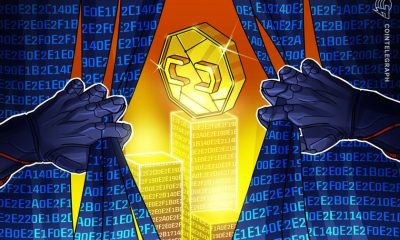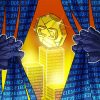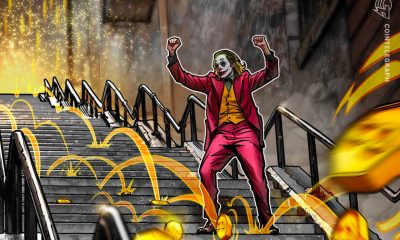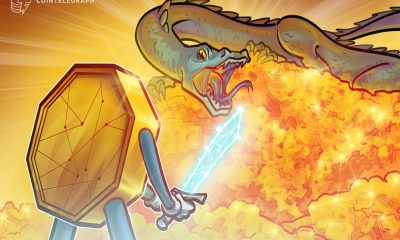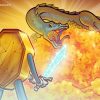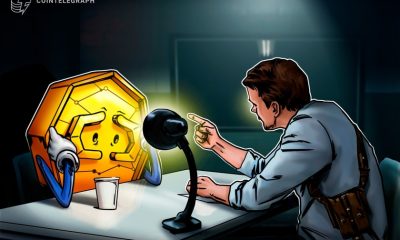Blockchain
NFT platforms: Going beyond marketplaces to deliver unique content

Why do artists need NTFs, and what can be done with such tokens, besides buying and selling? Here is the future of NFTs and blockchain.
The beginning of 2021 was marked by an unprecedented high interest in nonfungible token, or NFT, technology in various fields, the peak of which occurred in March. Nowadays, news about art deals with NFTs appears every day. What is more interesting is that NFTs are becoming fashionable among people who were previously ignorant of crypto.
Examples of how the NFT mania is reaching its peak can be seen through Beeple selling his art piece for almost $70 million and the likes of the Hermitage Museum in Saint Petersburg, Russia, announcing that it will hold an exhibition of NFT art in 2021.
What is the reason for such interest in NFTs, besides the hype generated by celebrities supporting the technology? Can a regular crypto enthusiast actually engage with NFTs in a user-friendly way?
So, why are NTF platforms developing so quickly, and what exactly are they? Here’s why NTF platforms are becoming crucial for attracting the art community, how these platforms actually work, and what they can offer their users apart from just being a type of marketplace.
The basics
The whole point is in the NTF itself, in its uniqueness. It cannot be replaced, faked or divided. The author of the token can prove their ownership, or the fact that a transfer of said ownership has taken place. That is, the owner of such a product can tokenize it by releasing an NFT, assigning a price to it and putting it up for auction. The buyer of such tokens receives the right to own and dispose of the goods, while information about this is recorded on the blockchain.
Operations with tokens are obviously cheaper, easier and faster than operations with real objects, although platforms for creating and selling NFTs have just begun to develop. However, NFTs are not completely covered by law, and proving ownership in terms of intellectual property rights may be challenging. Yes, unfortunately, not everyone accepts that blockchain is a legal record-keeping method.
What rights does the buyer have who spends their hard-earned dollars on the author’s token? If there is no legal agreement between the creator and the buyer of the NFT, the exclusive rights do not simply pass to the buyer with the purchase of the token.
Other rules may be established by the platform, but today, the standard terms of the largest platforms do not contain such rules. It is likely that the platforms will give the NFT creators the right to choose the licensing terms themselves.
Of course, any financial instrument cannot live long without state regulation. Here, NTFs are likely to take the path of conventional cryptocurrencies, and some believe that lawmakers will eventually intervene.
First is security, second is NFT
NTF platforms offer content in a variety of formats, so everyone can choose what sphere of art they wish to enter. But before getting in the industry, it is worth understanding how they work and whether they are safe, with regard to the potential risks.
For example, an NFT exists on the Ethereum blockchain. Having chosen the NFT platform, the user would need to create an Ethereum wallet, from which unique tokens will be bought and sold. Wallets help to authorize users on the platforms, in most cases without entering additional data like a username or password, as the wallet identifies the user using their wallet address. Some platforms require users to buy a native token to then purchase the artwork.
The principle of operation of any NTF platform is simple: Users come to the platform in order to secure the right to the created or purchased content, and as a confirmation, they receive a token, which can be freely traded with another user. From the point of view of security, the NTF itself already acts as a guarantee, as the blockchain contains information about the owner, whether they are a creator or a buyer.
But this does not mean that by buying an NFT, users can relax, as they are not safe from thefts on NFT platforms. For example, in March, the Nifty Gateway trading platform reported that some users were faced with account hijacking, theft and purchase of NFTs using a credit card without their knowledge. However, it turned out that none of the accounts had two-factor user authentication enabled.
It is not a question of poor security of NTF platforms, rather of the lack of knowledge on behalf of the users. All valuable items need to be stored safely, and NFT tokens are no exception. It’s not enough just to buy a token and store it on the platform — users need to protect their account and enable two-factor authentication, keep their password in a safe place, and indeed, most platforms provide such opportunities. Each owner of a valuable NTF must understand their responsibility and protect their item.
The NTF platforms
A regular person will usually purchase NFTs on special platforms — marketplaces, where tokens can be bought or sold. One of the largest and most popular marketplaces is OpenSea. This site contains thousands of different NFTs, from game cards to paintings by contemporary artists. The platform also maintains their ratings and tracks the most popular tokens.
Another marketplace is SuperRare, where digital art can be bought and sold but cannot be traded directly between users. On this platform, artists validate their work by creating a tokenized certificate. They set a selling price and allow potential buyers to bid on their pieces. The investment aspect of SuperRare is its aftermarket. Anyone can resell a purchased piece of art as if it were at a regular auction.
In the field of sports, the most interesting platform as of yet is NBA Top Shot. The concept of the project is to publish and sell digital basketball collectible cards. However, instead of static images of players, NBA Top Shot cards contain video clips from past games. Each token is truly a unique piece of memorabilia.
But is there something else besides marketplaces? Is the NFT industry limited to such projects with a buy-and-sell concept? Of course not. Today, some interesting projects are emerging, representing a variety of financial opportunities.
Some platforms are striving primarily for the convenience of NFT purchases, where a user can buy an item they like with a regular credit card. For example, Crypto.com’s NFT project does this by attracting as much unique content as possible, not only in the field of games but also from popular artists, musicians and athletes — to be multifaceted. It will be possible to purchase valuable items on the platform using cryptocurrencies.
The platform Rarible has become very popular, as it enables artists to collect royalties every time their work is resold. Rarible introduced a governance token called RARI and is taking steps toward developing itself into a decentralized autonomous organization. RARI tokenholders, who include NFT creators and collectors, can vote on platform updates and participate in market moderation.
The developers of the project are also planning to launch an NFT index — a special search engine for those who want to invest in the NFT market but are not sure which works of art to choose.
For those who like creative design, there is a project called Art Block. It’s one of the first platforms focused on the automatic generation of programmable content that is stored on the Ethereum blockchain. The uniqueness of the platform lies in the creation of an endless amount of content that can be bought and sold as NTFs.
Users on the platform can choose the art style that suits them and pay for the piece of work, and the platform will randomly generate a piece of content in the form of an image, 3D model or interactive design.
In general, it seems that crypto enthusiasts need much more than simple marketplaces to buy or sell NTFs. This is where multiplatforms come into play, enabling its various groups of users to create both unique content and invest in art. NFT platforms are no longer only a place for tokenizing digital art and various collectibles, they are also a mechanism for attracting users.
“Tehn,” a community manager at Blockchain Cuties Universe — a game that operates on four blockchains at once and stores game inventory in the form of NTFs — believes that NTF platforms can eventually offer a much more interesting approach than simple marketplaces:
“I believe that a vast majority will be marketplaces at first. But there’s more uses for NFTs. Games already utilize them to store value in the game asset and give players full control of their inventories and even monetize their ingame time. That’s the beauty of it. Blockchain allows developers to create great assets, and empower players to play their game, while having full control of their account.”




